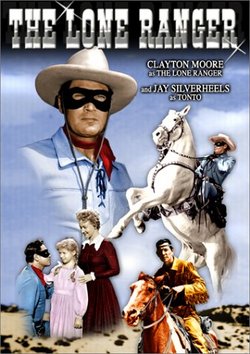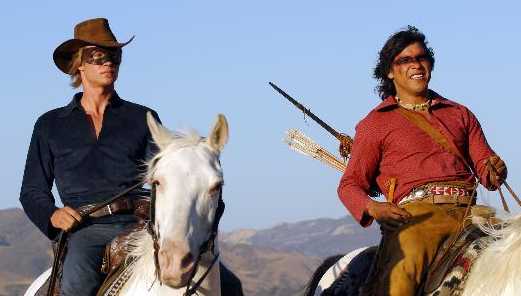Home |
Contents |
Photos |
News |
Reviews |
Store |
Forum |
ICI |
Educators |
Fans |
Contests |
Help |
FAQ |
Info


The Lone Ranger
(6/16/03)
 News and reviews of the Lone Ranger and Tonto in their various incarnations.
News and reviews of the Lone Ranger and Tonto in their various incarnations.
The Johnny Depp controversy
The origin of Tonto
Responses to redefining Tonto
Johnny Depp looks Indian?
Sheyahshe on Depp as Tonto
Johnny Depp to redefine Tonto?
Comments on (Mis)casting Depp as Tonto
Non-Natives in Native roles
Russ's stupidity about Johnny Depp
Fallacy of the big-name actor
Johnny Depp, Cherokee?
Johnny Depp as Tonto?!
New Lone Ranger movie?
Dynamite's LONE RANGER comic
Minorities in LONE RANGER #2
LONE RANGER sells out
Review of LONE RANGER #1
The Lone Ranger rides again
The Lone Ranger, WB-Style
An expanded version of my Indian Comics Irregular essay The Lone Ranger, WB-Style:
The WB Network, home of Gilmore Girls and Smallville (ICI #90), premiered a new Lone Ranger movie February 26. This Lone Ranger was politically correct toward Indians, at least; Tonto taught the Ranger everything he knew and was an equal partner. But it was filled with enough stereotypes, anachronisms, and other howlers to qualify it as a comedy. Some examples:
 The movie began with MTV-style camera shots and a hiphop theme that immediately suggested the WB's Dawson's Creek. Ironically, the actor who starred as the Ranger previously appeared in Dawson's Creek.
The first action featured white ruffians assaulting a beautiful Indian maiden, Alope, who wore a revealing buckskin dress. Luke Hartman, the future Ranger, tried to save her before her brother Tonto intervened. This set up a predictable "white man lusts for Indian woman" theme—which Tonto explicitly labeled "forbidden love" later.
Tonto called Hartman "white-eye" initially. (We can only give thanks that he didn't call him "paleface.")
A single woman ran the nascent Dallas Tribune. Another woman, Hartman's sister-in-law Grace, placed an ad for the first "department store."
Tonto was one of a band of Apaches who lived in tipis (!) a day's ride from Dallas. The Indians looked young and healthy, with long windblown hair, but were otherwise unremarkable.
The movie began with MTV-style camera shots and a hiphop theme that immediately suggested the WB's Dawson's Creek. Ironically, the actor who starred as the Ranger previously appeared in Dawson's Creek.
The first action featured white ruffians assaulting a beautiful Indian maiden, Alope, who wore a revealing buckskin dress. Luke Hartman, the future Ranger, tried to save her before her brother Tonto intervened. This set up a predictable "white man lusts for Indian woman" theme—which Tonto explicitly labeled "forbidden love" later.
Tonto called Hartman "white-eye" initially. (We can only give thanks that he didn't call him "paleface.")
A single woman ran the nascent Dallas Tribune. Another woman, Hartman's sister-in-law Grace, placed an ad for the first "department store."
Tonto was one of a band of Apaches who lived in tipis (!) a day's ride from Dallas. The Indians looked young and healthy, with long windblown hair, but were otherwise unremarkable.
 Tonto was the son of the tribe's chief, making Alope the classic chief's daughter.
Wes Studi played a medicine man or "shaman" who provided bits of wisdom. Among his tricks was throwing powder into a fire to make it flare.
While Hartman recovered from a wound, Alope rubbed his naked chest. Later, Hartman was soaking in a spring inside a lodge (!). Alope came in, disrobed, and joined him in the pseudo-hot tub...until Hartman woke up and realized he was dreaming.
Hartman begged Tonto to teach him how to fight. Tonto agreed but said he'd have to "break our laws" to do it. The "illicit" training included a generic vision quest (done "before any battle"), a kind of Indian kung fu (satirist Joe Bob Briggs would call it "Indian fu"), and archery. They got in shape by sparring and jogging, like Sylvester Stallone in Rocky, and rock climbing. (The movie didn't explain why physical activities such as archery or jogging would be against Apache law.)
Hartman's spirit guide turned out to be the horse Silver, who appeared out of nowhere. Later Silver prevented him from killing a villain, teaching Hartman a valuable moral lesson: "Not even hate is reason enough to kill."
Tonto also showed a superhuman ability to leap a dozen feet through the air like the combatants in Crouching Tiger, Flying Dragon. It was clear Hartman would emulate this feat when he had to.
At one point Hartman and Tonto had to cross a river. "This is a river, go with the flow," said Tonto.
Hartman called Tonto "kemosabe," thinking it meant "friend" in Apache. Tonto told him not to call him that. Eventually Hartman learned "kemosabe" is reserved for people who have saved each other's lives, thus forming a sacred bond.
Studi painted his face in a mask-like fashion and told Hartman to wear a similar disguise—to fill wrongdoers with nightmares. In the time-honored tradition of heroes, none of Hartman's relatives recognized him in his mask, even though he looked the same.
As a proto-Indian activist, Tonto rallied his people to fight the villains. "Let's show them we're not savages," he exhorted.
As a Sherlock Holmes-like tracker, Tonto found a bit of matter on a boot and immediately identified where it came from.
The Lone Ranger and Tonto defeated the villains with plenty of Indian fu and another impossible leap through the air.
Before the Lone Ranger and Tonto rode off into the sunset, Alope appeared once more in an off-shoulder blouse with a bare midriff.
Tonto was the son of the tribe's chief, making Alope the classic chief's daughter.
Wes Studi played a medicine man or "shaman" who provided bits of wisdom. Among his tricks was throwing powder into a fire to make it flare.
While Hartman recovered from a wound, Alope rubbed his naked chest. Later, Hartman was soaking in a spring inside a lodge (!). Alope came in, disrobed, and joined him in the pseudo-hot tub...until Hartman woke up and realized he was dreaming.
Hartman begged Tonto to teach him how to fight. Tonto agreed but said he'd have to "break our laws" to do it. The "illicit" training included a generic vision quest (done "before any battle"), a kind of Indian kung fu (satirist Joe Bob Briggs would call it "Indian fu"), and archery. They got in shape by sparring and jogging, like Sylvester Stallone in Rocky, and rock climbing. (The movie didn't explain why physical activities such as archery or jogging would be against Apache law.)
Hartman's spirit guide turned out to be the horse Silver, who appeared out of nowhere. Later Silver prevented him from killing a villain, teaching Hartman a valuable moral lesson: "Not even hate is reason enough to kill."
Tonto also showed a superhuman ability to leap a dozen feet through the air like the combatants in Crouching Tiger, Flying Dragon. It was clear Hartman would emulate this feat when he had to.
At one point Hartman and Tonto had to cross a river. "This is a river, go with the flow," said Tonto.
Hartman called Tonto "kemosabe," thinking it meant "friend" in Apache. Tonto told him not to call him that. Eventually Hartman learned "kemosabe" is reserved for people who have saved each other's lives, thus forming a sacred bond.
Studi painted his face in a mask-like fashion and told Hartman to wear a similar disguise—to fill wrongdoers with nightmares. In the time-honored tradition of heroes, none of Hartman's relatives recognized him in his mask, even though he looked the same.
As a proto-Indian activist, Tonto rallied his people to fight the villains. "Let's show them we're not savages," he exhorted.
As a Sherlock Holmes-like tracker, Tonto found a bit of matter on a boot and immediately identified where it came from.
The Lone Ranger and Tonto defeated the villains with plenty of Indian fu and another impossible leap through the air.
Before the Lone Ranger and Tonto rode off into the sunset, Alope appeared once more in an off-shoulder blouse with a bare midriff.
In short, The Lone Ranger established Tonto as the strong, independent warrior he would have been. Almost everything else about its portrayal of Indians was dubious.
More on the Lone Ranger and Tonto
Related links
Tonto
TV shows featuring Indians
The best Indian movies
Readers respond
"[W]hat's so stereotypical about the 'white man lusts for Indian woman'?"
* More opinions *
|
|
. . .
|

|
Home |
Contents |
Photos |
News |
Reviews |
Store |
Forum |
ICI |
Educators |
Fans |
Contests |
Help |
FAQ |
Info
All material © copyright its original owners, except where noted.
Original text and pictures © copyright 2007 by Robert Schmidt.
Copyrighted material is posted under the Fair Use provision of the Copyright Act,
which allows copying for nonprofit educational uses including criticism and commentary.
Comments sent to the publisher become the property of Blue Corn Comics
and may be used in other postings without permission.
 News and reviews of the Lone Ranger and Tonto in their various incarnations.
News and reviews of the Lone Ranger and Tonto in their various incarnations. News and reviews of the Lone Ranger and Tonto in their various incarnations.
News and reviews of the Lone Ranger and Tonto in their various incarnations.

